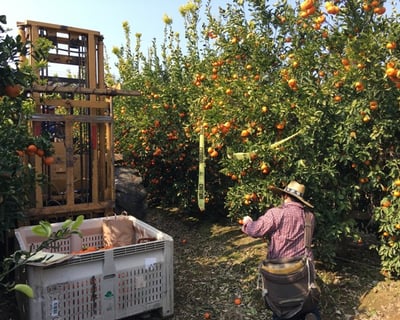A New Approach to Best Nitrogen Management Practices in Citrus
by Douglas Amaral & Francielle Lima @ University of California Cooperative Extension


Nitrogen in citrus orchards
Currently nitrogen applications in citrus are based largely on leaf sampling and application of critical value analysis. Critical value is the nutrient concentration in a standard leaf sample at which yield is 90% of the maximum yield. This approach provides an indication of adequacy or deficiency but little specific information on appropriate fertilizer rates or timing of applications. Although the critical value approach has been a valuable tool to identify deficiencies and toxicities, this approach is not sensitive to over fertilization and is collected too late in the season to be used as a management tool. Leaf sampling has been found to be an inadequate tool for N management in high value crops since it is inadequately sensitive to N fertilizer applications.
In addition, applying N more than the crop demand not only increase the potential for nitrate leaching, but also affects fruit yield and quality. It has been found that leaf N level were associated with a reduction in fruit size, juice % and ascorbic acid, and an increase in peel thickness, coarseness of peel texture and amount of green color on peel at harvest time. Increasing N concentration in leaves over 2.4% reduced fruit size, slightly increased number of fruits and had no effect on yield volume.
Nitrogen use efficiency
Currently, citrus growers in California apply 150-250 lbs N per acre in 3-6 splits and monitor N adequacy by collecting leaf samples from 5-7 months old leaves in late summer. This problem is particularly evident since over 80% of N uptake occurs by the time results of a late summer tissue sampling are available to the grower. Therefore, ‘nutrient budgeting’ is a more sophisticated and appropriate method to make nutrient decisions. The nutrient budgeting approach requires an early season estimation of expected yield and tree nutrient status, a mid-season update of the yield estimate and in season adaptation of N applications. To establish this methodology, it requires the development of annual nutrient uptake curves and methods to conduct nutrient sampling in the early spring.
Nitrogen demand in citrus trees
According to a recent study conducted at University of California-Davis in collaboration with the California Department of Food and Agriculture (CDFA), fertilizer rate decisions in citrus orchards should be based on nutrient export in expected yield while fertilizer application rates and timings should be based upon the pattern of nutrient accumulation in fruits. The methodology used in this research allowed the researchers to estimate the annual amounts of nutrients that field grown orange and mandarin trees absorbed and allocated to above ground organs. Knowing the dynamics of nutrient uptake during the season is a requirement to allow the management of the timing of nutrient supply with nutrient needs and to avoid nutrient losses, especially N-Nitrate (NO3).
In summary, the seasonal demand of N in citrus is high early in the season from March through August with 80-90% of the total N accumulated by late August in both species. Nitrogen uptake rapidly occurs from bloom and during fruit development, which also coincides with vegetative growth, and decreases during fruit maturation. Most of the other nutrients (P, K, Ca, Mg) followed the same pattern with a rapid accumulation at early stages of fruit growth and a decrease accumulation during fruit maturation. In oranges, the export of Nitrogen was estimated to be 1.5 lbs. per 1000 lbs. of fruits and in mandarins, the export of Nitrogen was estimated to be 1.3 lbs. per 1000 lbs. of fruits. Biomass N accumulation was estimated to be 0.15 lb. of N per mature citrus tree. The data suggests that nutrients should be available in the soil for roots to uptake from March to November. In contrast, from December to February, no significant net increase in nutrient was observed during this period.
TRAP the nitrogen in the soil
When making fertilization decisions, growers need to consider the different supplies of N, as well as the demand for N due to tree growth and especially fruit production requirements. Yield potential determines fertilizer strategy and there is a large negative impact on overall efficiency that occurs in years or orchards of poor yield in which standardized fertilization strategies are used. Therefore, fertilizing according to predicted yields will dramatically enhance nutrient use efficiency.
In addition, an understanding of all different resources that will improve N use efficiency (fertilizer, compost, cover crop, manure, efficient irrigation system, etc.) and how N can be “lost” (run-off, leaching, etc.) in the orchard will help growers better make management decisions. In summary, remember to “TRAP” N in the soil:
o Time: time N application according to tree uptake patterns.
o Resources: properly manage all resources that will improve N use efficiency.
o Amount: apply the amount of N needed according to tree demand.
o Place: place N to the tree’s active root zone.
Following this principle can be viewed as a balancing act with the goal of applying adequate N to supply tree demand for growth and fruit production.
Currently, nutrient management decisions in citrus are based on leaf analysis and critical value interpretation which only indicates a deficiency or sufficiency and is performed too late to respond to deficiencies or plan N applications. To this end, a holistic nutrient management protocol was developed to guide the fertilization rate and time of fertilizer application as well as in season monitoring to adjust fertilizer rate to optimize yield and reduce leaching of nitrate.
